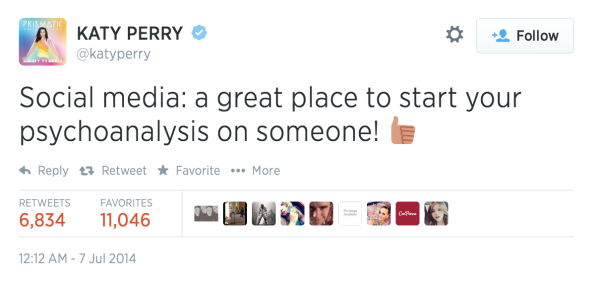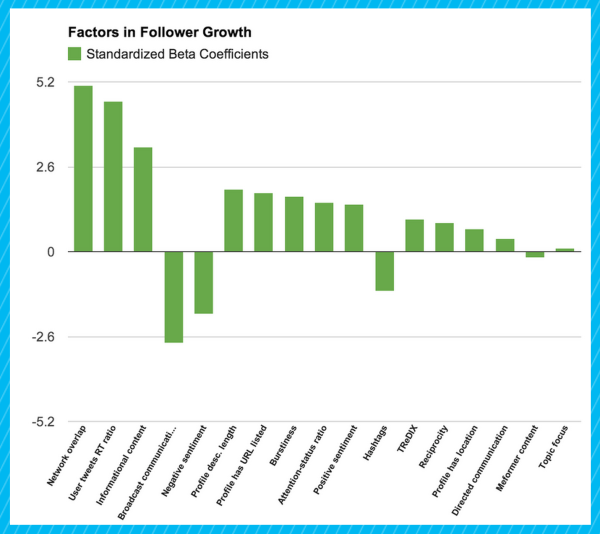Brands
What Katy Perry (and a Scientific Study) Can Tell You About Rocking Twitter
Are you #blessed with an exceedingly large Twitter following? You’re obviously doing something right, and researchers from the Georgia Institute of Technology and the University of Michigan might have figured out what that something is.
With data compiled over 15 months from 507 Twitter accounts and a half-million tweets, the team analyzed what factors influenced users to follow a particular account. Their recently published paper, “A Longitudinal Study of Follow Predictors on Twitter,” examined users’ social behavior choices, tweet content, and social network structure—all things to keep in mind if you ever want to surpass Katy Perry. But it might take a while: At over 54 million followers, Perry is currently champion of Twitter, because she knows how to play the game.
 Inside A Longitudinal Study of Follow Predictors on Twitter
Inside A Longitudinal Study of Follow Predictors on Twitter
The study looked at a variety of individual factors, including tweet volume, tweets per hour, interactions, amount of impersonal broadcasting, profile trustworthiness, positive/negative sentiment, informational content, self-referencing, retweets, use of hashtags, readability, reciprocity, and network overlap. Obviously, no two factors are made the same, and some appear to have more power than others. (Let’s take a collective moment to acknowledge that the study is correlational, not causational, so we understand that the effectiveness of these factors are not set in stone.)
Via BufferBlog
As the graph above shows, your network connection—how similar the people you follow are to the people someone else follows—has the greatest effect on whether or not people will follow you. Next in line, the BufferBlog says, is how often you are retweeted (in comparison to how much you tweet) and informational content.
The study can’t emphasize enough that “Message content significantly impacts follower growth.” Informational content (defined in the study as tweets containing a URL or a reference to another tweet, e.g., RT or MT) in an account will make an impact 30 times greater than “meformer” content (personal tweets about the user). According to PsyBlog, only around 20 percent of Twitter users share information and reply to other users—these are the informers—whereas 80 percent—the meformers—mostly send out information about themselves.
You and your brand want to be in the 20 percent. This should sound like overplayed advice by now, but here it goes: Tweet about things your audience is interested in, rather than solely about your own products. Also, remember to keep it positive. Tweeting negative sentiments will actually hurt your following, while positive sentiments will only boost it. And interact directly with your followers, rather than only sending out “broadcasts.” Twitter users appreciate when @mentions are responded to, even if it’s not their own, because it shows a real personality and presence behind the handle. Make outreach part of your regular Twitter routine.
PsyBlog also has a few more do’s and don’ts for Twitter users, some of which are more obvious than others. Make sure to personalize your profile, so people realize that there’s an actual human behind your tweets—add a web address, a location, and a nice description. Write well, and use actual grammar in those 140 characters. And, most important for brands trying (and failing) to be hip: Lay off the hashtags. The study doesn’t specify what exactly constitutes “hashtag abuse,” but please, keep them to a minimum (unless it’s time for Throwback Thursday, in which case, #tbt away!).
Brands should keep in mind that when they’re on Twitter, they’re talking to humans—not just demographics, not just “consumers,” but people. Read the rest of the study for deeper insights, and keep telling yourself: I am a champion and you’re gonna hear me rooooAAAARRRR!
What’s the deal with The Content Strategist? It’s something we created at Contently because we believe in a world where marketing is helpful and where businesses grow by telling stories that people love. Learn more.
Image by Felipe Dana/APGet better at your job right now.
Read our monthly newsletter to master content marketing. It’s made for marketers, creators, and everyone in between.







